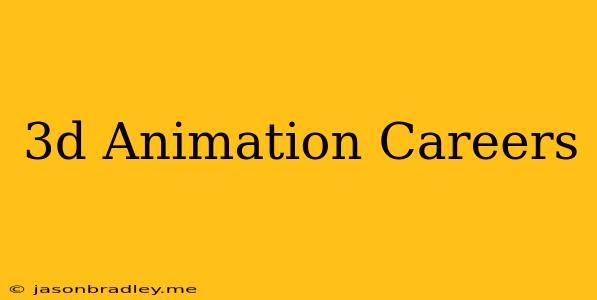3D Animation Careers: Bringing Imagination to Life
3D animation has become an integral part of modern entertainment, media, and even everyday life. From blockbuster movies and video games to commercials and product demonstrations, the demand for skilled 3D animators is constantly growing.
If you're passionate about visual storytelling and have a knack for creating immersive experiences, a career in 3D animation could be the perfect fit for you.
Here are some popular career paths you can explore:
1. 3D Animator
This is the core role in the animation industry. 3D animators use specialized software to bring characters, creatures, and objects to life. They create realistic movements, expressions, and interactions, making characters appear believable and engaging.
Responsibilities:
- Modeling and rigging characters and objects
- Creating realistic animations and special effects
- Collaborating with other artists and designers
- Working with deadlines and production schedules
Skills:
- Proficiency in 3D animation software (Maya, Blender, 3ds Max)
- Strong artistic skills and understanding of anatomy and movement
- Ability to work independently and as part of a team
- Excellent communication and problem-solving skills
2. 3D Character Animator
Specializing in character animation, this role focuses on bringing life to human, animal, or even fantasy characters. They create believable performances, capturing nuances in facial expressions, body language, and emotional states.
Responsibilities:
- Developing and animating character rigs
- Creating detailed facial animations and expressions
- Enhancing character movement and interaction
- Working closely with directors and storyboards
Skills:
- In-depth knowledge of character rigging and animation techniques
- Strong understanding of human and animal anatomy and movement
- Experience with motion capture technology
- Exceptional artistic creativity and attention to detail
3. 3D VFX Artist
VFX artists create stunning visual effects for movies, television shows, and video games. They use 3D software to generate realistic environments, explosions, weather phenomena, and other special effects that enhance the visual storytelling.
Responsibilities:
- Creating realistic environments, objects, and textures
- Simulating special effects like fire, water, and smoke
- Integrating VFX into live-action footage
- Working with compositing software to create seamless visual effects
Skills:
- Proficiency in 3D modeling, texturing, and lighting
- Understanding of physics and fluid dynamics
- Experience with compositing software like Nuke or After Effects
- Creative eye for detail and a passion for visual storytelling
4. 3D Game Animator
Game animators bring life to characters, creatures, and environments in video games. They create believable and engaging animations that enhance the player's experience.
Responsibilities:
- Animating characters, weapons, and other in-game elements
- Designing and implementing animations for different game mechanics
- Working closely with game developers and designers
- Optimizing animations for different platforms and game engines
Skills:
- Knowledge of game development pipelines and tools
- Understanding of game physics and animation principles
- Ability to create realistic and stylized animations
- Passion for video games and the gaming industry
5. 3D Motion Graphics Artist
Motion graphics artists use 3D animation and visual effects to create dynamic and engaging graphics for commercials, marketing materials, and digital platforms. They create eye-catching animations, logos, titles, and transitions.
Responsibilities:
- Designing and animating logos, titles, and other graphical elements
- Creating motion graphics for advertising, branding, and social media
- Working with compositing software to integrate graphics into video content
- Staying up-to-date with the latest trends in motion graphics and animation
Skills:
- Proficiency in 3D animation and compositing software
- Strong graphic design skills and understanding of visual aesthetics
- Ability to work with tight deadlines and meet client expectations
- Excellent communication and collaboration skills
Getting Started in 3D Animation
There are many resources available to help you learn 3D animation, including online courses, tutorials, and degree programs.
Start with the Basics:
- Familiarize yourself with 3D animation software (Maya, Blender, 3ds Max)
- Learn the fundamentals of 3D modeling, texturing, and lighting
- Practice creating simple animations and experimenting with different techniques
- Explore online tutorials and communities to expand your knowledge
Build a Portfolio:
- Showcase your best work in a professional portfolio
- Create projects that demonstrate your skills and artistic style
- Participate in online challenges and competitions to gain experience
- Network with other animators and industry professionals
Career Paths:
- Freelance Animator: Work independently on various projects
- Studio Animator: Join a studio and collaborate on larger projects
- Game Developer: Work for a video game company
- Advertising Agency: Create visual content for marketing campaigns
With dedication, creativity, and the right skills, you can turn your passion for 3D animation into a successful and rewarding career.
